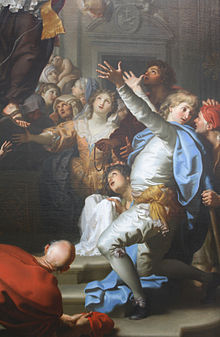Giovanni Battista Righi was an Italian Roman Catholic priest and a professed member from the Order of Friars Minor. He was known for ascetic life and for his preaching and healing abilities.
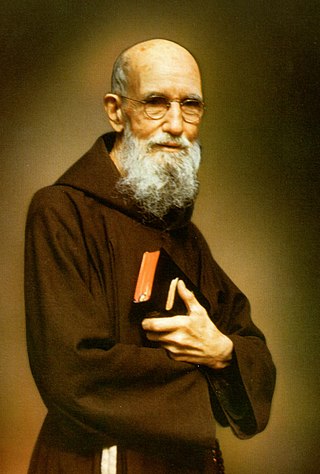
Solanus Casey, OFM Cap, born Bernard Francis Casey, was an American religious priest of the Order of Friars Minor Capuchin. He was known during his lifetime as a healer for his great faith and his abilities as a spiritual counselor, but especially for his great attention to the sick, for whom he celebrated special Masses. The friar was much sought-after and revered, especially in Detroit, where he resided. He was also a noted lover of the violin, a trait he shared with his eponym, Saint Francis Solanus.

Bartholomew of Braga, born Bartolomeu Fernandes and in religious Bartolomeu dos Mártires, was a Portuguese Catholic and a professed member from the Order of Preachers as well as the Archbishop Emeritus of Braga. Fernandes participated in the Council of Trent and also collaborated with Charles Borromeo at the council while also establishing a series of hospitals and hospices in Braga while publishing a range of works from catechism to other topics.
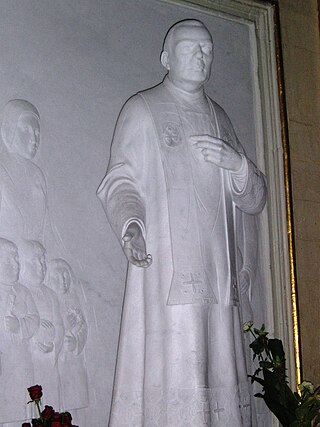
Filippo Smaldone was an Italian Roman Catholic priest and the founder of the Salesian Sisters of the Sacred Hearts. Smaldone is best known for his extensive work with the deaf during his lifetime. Smaldone was a gifted preacher known for his commitment to proper catechesis and to the care of orphans and the mute, which earned him civic recognition.

Johannes Ludovicus Paquay, also known as Valentinus, was a Belgian Roman Catholic priest and a professed member from the Order of Friars Minor. He was a popular confessor and noted preacher while serving in various leadership positions in the house he was stationed in; he was also known for his popular devotion to the Eucharist and the Sacred Heart and promoted these devotions to the faithful and to his conferees alike.
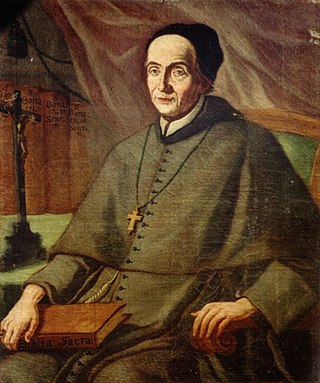
Antonio Lucci, born Angelo Nicola Lucci, was an Italian Roman Catholic professed member from the Order of Friars Minor Conventual and served as the Bishop of Bovino from 1729 until his death.
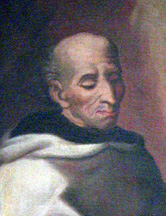
Angelo Paoli, O.Carm – born Francesco – was an Italian Catholic priest and a professed member from the Carmelites. Paoli became known as the "father of the poor" due to his strong charitable outreach, for which he received praise from a number of cardinals and other prelates while living in Rome. This extended to his friend Cardinal Giuseppe Maria Tomasi and to Popes Innocent XII and Clement XI, who both offered him the cardinalate, which he refused.

Josep Manyanet i Vives, SF was a Spanish Roman Catholic priest and the founder of the Sons of the Holy Family and the Missionary Daughters of the Holy Family. He served in a range of capacities as a parish priest before establishing both religious orders in order to spread devotion to the Holy Family to whom he fostered an intense devotion.

Giulia Salzano was an Italian Roman Catholic professed religious and the founder of the Catechetical Sisters of the Sacred Heart of Jesus (1905). Salzano served as a teacher prior to becoming a religious and since 1865 worked in Casoria as a teacher for children where she demonstrated herself as an apt catechist and instructor.

Egidio Maria of Saint Joseph - born Francesco Pontillo - was an Italian professed religious of the Order of Friars Minor. Pontillo became a Franciscan brother rather than an ordained priest due to his lack of a proper education and so dedicated himself to the care of the poor and ill in southern Italian cities such as Taranto and Naples where he earned the moniker of the "Consoler of Naples".

Claudio Granzotto was an Italian professed religious from the Order of Friars Minor and a noted sculptor. Granzotto's works were a conduit for his religious expression and are reflective of his dedication to use sculpting to evangelize to others.

Cristóbal of Saint Catherine – born Cristóbal López de Valladolid Orea – was a Roman Catholic Spanish priest and a professed member of the Third Order of Saint Francis. He was the founder of the Franciscan Hospitallers of Jesus of Nazareth which paid careful attention to both religious and social needs of the faithful.

Tommaso da Olera - born Tommaso Acerbis was a Roman Catholic Italian friar of the Capuchins. Leading a life of humility and service, Acerbis, initially a shepherd with no formal education, joined the Order of Friars Minor Capuchin in Verona at the age of seventeen. He served in various convents, offering spiritual guidance to the sick and impoverished. Acerbis spoke out against the spread of Lutheranism, defending the Roman Catholic Church through his love for "the impassioned Christ". His influence extended to sponsoring convents and spiritually guiding notable individuals, including Bernardina Floriani and scientist Ippolito Guarinoni. Acerbis's devotion earned him papal veneration, with Pope John XXIII recognizing him as "a saint and a true master of the spirit". The beatification process, initiated in 1967, culminated in his proclamation as Venerable on 23 October 1987. A miracle further validated his cause, leading to beatification on 21 September 2013, presided over by Cardinal Angelo Amato on behalf of Pope Francis.
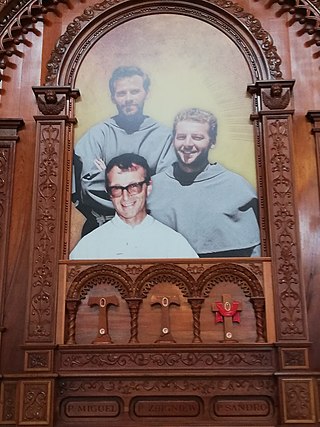
The Three Martyrs of Chimbote were a group of two Polish Franciscan priests and one Italian missionary priest murdered in Peru in 1991 by the Shining Path communist guerillas. Michał Tomaszek and Zbigniew Adam Strzałkowski, and Alessandro Dordi were murdered on 9 August and 25 August 1991 respectively.

Tommaso Maria Fusco was an Italian Roman Catholic priest who established the Daughters of Charity of the Most Precious Blood.
Giacomo Abbondo was an Italian Roman Catholic priest who hailed from Vercelli. Abbondo served as a pastor and provost in his home town of Tronzano where he administered to the people while proclaiming the message of the Gospel and bringing the sacraments to his parishioners.

Giuseppe Marcinò, religious name Innocenzo of Caltagirone, was an Italian priest and a member of the Capuchins. He was well known for his frequent and often sensational predications and miracles attributed to him since 1623. Due to this he was granted the moniker of "the miracle worker of the earth".

Josep Tous Soler was a Spanish Roman Catholic priest and a professed member of the Order of Friars Minor Capuchin - a branch of the Franciscan Order. Upon becoming a friar he was called by the religious name Josep of Igualada and went on to preach across both Spain and France.

Luca Antonio Falcone – in religious life Angelo – was an Italian Roman Catholic priest and a professed member of the Franciscan Order of Friars Minor Capuchin in Cosenza. Falcone had a rough call to religious life after several entries and exits into the order and he later served as a noted preacher across southern Italian cities such as Catanzaro and Salerno after his first few sermons attracted little following. He became titled as both the "Angel of Peace" and the "Apostle of the South".

Giacomo Bianconi was an Italian Roman Catholic priest and a professed member of the Order of Preachers. Bianconi - who hailed from Umbria - joined the order in his adolescence and dedicated his pastoral career to his flock and on one notable occasion aided refugees when Frederick II sacked the area in 1248. He also combatted heresies and managed to convert one of their chief propagators while also distinguishing himself through his life of extreme poorness that went past the Dominican standards.
